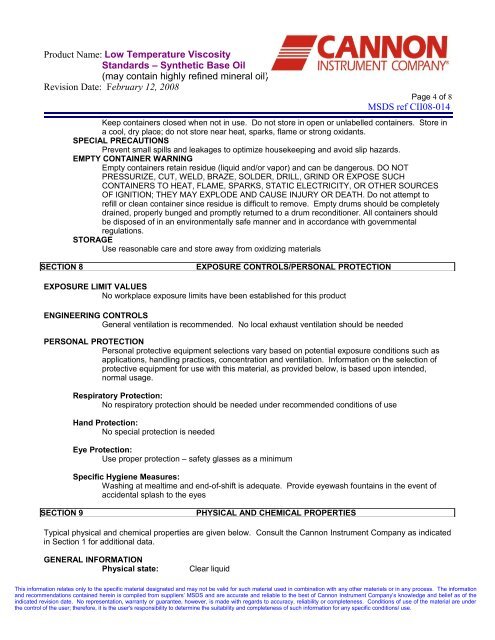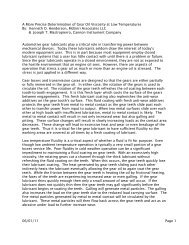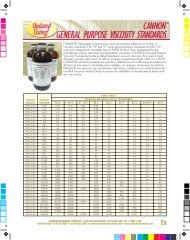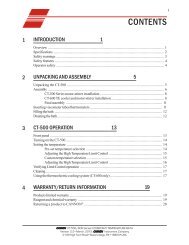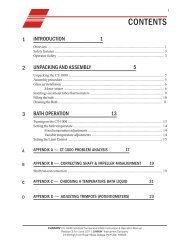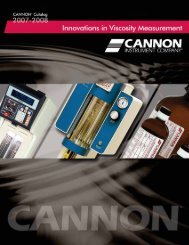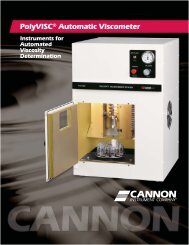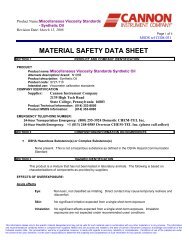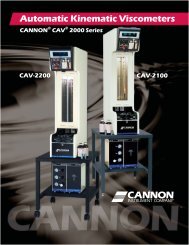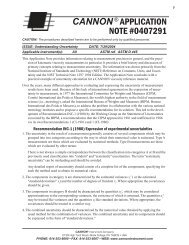MATERIAL SAFETY DATA SHEET - Cannon Instrument Company
MATERIAL SAFETY DATA SHEET - Cannon Instrument Company
MATERIAL SAFETY DATA SHEET - Cannon Instrument Company
Create successful ePaper yourself
Turn your PDF publications into a flip-book with our unique Google optimized e-Paper software.
Product Name: Low Temperature Viscosity<br />
Standards – Synthetic Base Oil<br />
(may contain highly refined mineral oil)<br />
Revision Date: February 12, 2008<br />
Page 4 of 8<br />
MSDS ref CII08-014<br />
Keep containers closed when not in use. Do not store in open or unlabelled containers. Store in<br />
a cool, dry place; do not store near heat, sparks, flame or strong oxidants.<br />
SPECIAL PRECAUTIONS<br />
Prevent small spills and leakages to optimize housekeeping and avoid slip hazards.<br />
EMPTY CONTAINER WARNING<br />
Empty containers retain residue (liquid and/or vapor) and can be dangerous. DO NOT<br />
PRESSURIZE, CUT, WELD, BRAZE, SOLDER, DRILL, GRIND OR EXPOSE SUCH<br />
CONTAINERS TO HEAT, FLAME, SPARKS, STATIC ELECTRICITY, OR OTHER SOURCES<br />
OF IGNITION; THEY MAY EXPLODE AND CAUSE INJURY OR DEATH. Do not attempt to<br />
refill or clean container since residue is difficult to remove. Empty drums should be completely<br />
drained, properly bunged and promptly returned to a drum reconditioner. All containers should<br />
be disposed of in an environmentally safe manner and in accordance with governmental<br />
regulations.<br />
STORAGE<br />
Use reasonable care and store away from oxidizing materials<br />
SECTION 8<br />
EXPOSURE CONTROLS/PERSONAL PROTECTION<br />
EXPOSURE LIMIT VALUES<br />
No workplace exposure limits have been established for this product<br />
ENGINEERING CONTROLS<br />
General ventilation is recommended. No local exhaust ventilation should be needed<br />
PERSONAL PROTECTION<br />
Personal protective equipment selections vary based on potential exposure conditions such as<br />
applications, handling practices, concentration and ventilation. Information on the selection of<br />
protective equipment for use with this material, as provided below, is based upon intended,<br />
normal usage.<br />
Respiratory Protection:<br />
No respiratory protection should be needed under recommended conditions of use<br />
Hand Protection:<br />
No special protection is needed<br />
Eye Protection:<br />
Use proper protection – safety glasses as a minimum<br />
Specific Hygiene Measures:<br />
Washing at mealtime and end-of-shift is adequate. Provide eyewash fountains in the event of<br />
accidental splash to the eyes<br />
SECTION 9<br />
PHYSICAL AND CHEMICAL PROPERTIES<br />
Typical physical and chemical properties are given below. Consult the <strong>Cannon</strong> <strong>Instrument</strong> <strong>Company</strong> as indicated<br />
in Section 1 for additional data.<br />
GENERAL INFORMATION<br />
Physical state:<br />
Clear liquid<br />
This information relates only to the specific material designated and may not be valid for such material used in combination with any other materials or in any process. The information<br />
and recommendations contained herein is compiled from suppliers’ MSDS and are accurate and reliable to the best of <strong>Cannon</strong> <strong>Instrument</strong> <strong>Company</strong>’s knowledge and belief as of the<br />
indicated revision date. No representation, warranty or guarantee, however, is made with regards to accuracy, reliability or completeness. Conditions of use of the material are under<br />
the control of the user; therefore, it is the user's responsibility to determine the suitability and completeness of such information for any specific conditions/ use.


